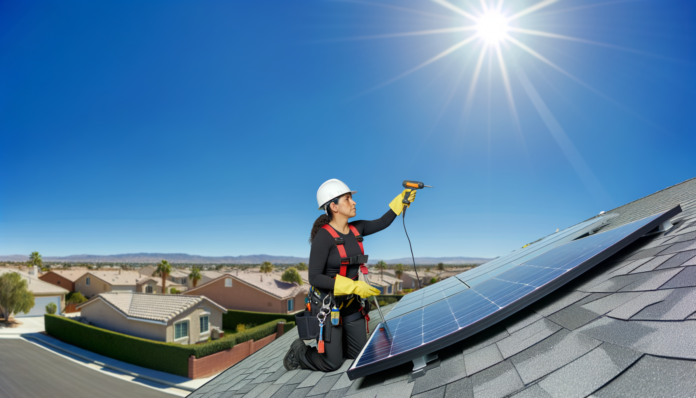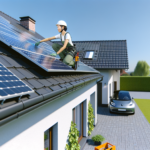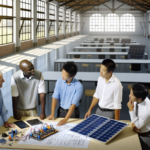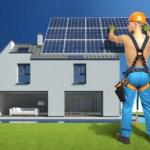Introduction
Importance of Solar Power Maintenance
Solar power systems are a significant investment, both financially and environmentally. They harness the sun’s energy to provide a clean, renewable source of electricity, reducing reliance on fossil fuels and lowering carbon footprints. However, like any other technology, solar power systems require regular maintenance to ensure they operate at peak efficiency and longevity.
Regular maintenance is crucial for several reasons:
- Optimal Performance: Dust, dirt, and debris can accumulate on solar panels, reducing their efficiency. Regular cleaning and inspections help maintain their ability to capture sunlight effectively.
- Longevity: Routine checks can identify and address minor issues before they escalate into major problems, thereby extending the lifespan of the system.
- Cost Savings: Preventive maintenance can save money by avoiding costly repairs and replacements. It also ensures that the system continues to generate maximum energy, providing a better return on investment.
- Safety: Regular inspections can identify potential safety hazards, such as damaged wiring or loose mounts, which could pose risks if left unaddressed.
Who This Guide is For
This guide is designed for a wide range of readers, including:
- Homeowners: Individuals who have installed solar power systems on their properties and want to ensure they are well-maintained.
- Business Owners: Companies that rely on solar energy for their operations and need to keep their systems running efficiently.
- Solar Installers: Professionals who install solar power systems and want to provide their clients with comprehensive maintenance advice.
- Facility Managers: Those responsible for the upkeep of solar power systems in larger installations, such as schools, hospitals, and industrial facilities.
Whether you are a novice or an experienced solar power user, this guide will provide valuable insights and practical tips to help you maintain your system effectively.
Overview of the Checklist
Maintaining a solar power system involves several key tasks, each of which is crucial for ensuring optimal performance and longevity. This guide will walk you through a comprehensive maintenance checklist, covering the following areas:
- Safety Precautions: Essential safety measures to protect yourself and your system during maintenance activities.
- Visual Inspection: Steps to visually inspect your solar panels, mounting structures, and electrical connections for any signs of damage or wear.
- Cleaning and Maintenance: Best practices for cleaning solar panels, maintaining inverters, and caring for batteries.
- Performance Monitoring: How to use monitoring systems to track your system’s performance and troubleshoot common issues.
- Seasonal and Annual Checks: Specific maintenance tasks to prepare your system for different seasons and the importance of annual professional inspections.
By following this checklist, you can ensure that your solar power system remains efficient, safe, and reliable for years to come. Regular maintenance not only maximizes energy production but also protects your investment, contributing to a sustainable and cost-effective energy solution.
Safety Precautions
Personal Safety Measures
Ensuring personal safety is paramount when performing maintenance on your solar power system. Here are some essential safety measures to follow:
- Wear Appropriate Gear: Always wear protective clothing, including gloves, safety glasses, and non-slip shoes. If you are working on a rooftop, a safety harness is crucial.
- Stay Hydrated: Working outdoors, especially in hot weather, can lead to dehydration. Keep water handy and take regular breaks.
- Work in Pairs: If possible, have someone with you. This is especially important for rooftop work, where falls can be dangerous.
- Avoid Wet Conditions: Never perform maintenance during rain or when the panels are wet. Wet conditions increase the risk of electrical shock.
System Shutdown Procedures
Before beginning any maintenance work, it is crucial to shut down your solar power system properly to avoid electrical hazards. Follow these steps:
- Turn Off the Inverter: The inverter is the heart of your solar power system. Locate the inverter and switch it off. This will stop the flow of electricity from the panels to your home or business.
- Disconnect the AC and DC Isolators: These isolators are usually located near the inverter. Turn off the AC isolator first, followed by the DC isolator. This ensures that both the alternating current (AC) and direct current (DC) circuits are safely disconnected.
- Verify the Shutdown: Check the inverter display to ensure it shows no power flow. Use a multimeter to confirm that there is no voltage present in the system.
Tools and Equipment Needed
Having the right tools and equipment is essential for safe and effective maintenance of your solar power system. Here is a list of items you will need:
- Multimeter: For measuring voltage and ensuring the system is properly shut down.
- Soft Brush and Sponge: For cleaning the solar panels without scratching them.
- Safety Harness: Essential for rooftop work to prevent falls.
- Insulated Tools: Use insulated screwdrivers and pliers to reduce the risk of electrical shock.
- Cleaning Solution: A mild, non-abrasive cleaning solution specifically designed for solar panels.
- Protective Gear: Gloves, safety glasses, and non-slip shoes.
- Logbook: To record maintenance activities and any issues found.
By adhering to these safety precautions, you can ensure that your maintenance activities are conducted safely and effectively, thereby prolonging the life and efficiency of your solar power system.
Visual Inspection
Checking Solar Panels
Regular visual inspections of your solar panels are crucial for maintaining their efficiency and longevity. Begin by examining the surface of each panel for any visible dirt, debris, or damage. **Look for cracks, chips, or discoloration** on the glass surface, as these can significantly impact the panel’s ability to capture sunlight effectively.
Next, ensure that there are no obstructions such as tree branches or other objects casting shadows on the panels. **Shading can drastically reduce the energy output** of your solar system. Additionally, check for any signs of bird droppings or nests, as these can also block sunlight and cause damage over time.
**Inspect the panel frames** for any signs of wear and tear. The frames should be intact and free from corrosion. If you notice any loose or damaged frames, it’s essential to address these issues promptly to prevent further damage.
Inspecting Mounting and Racking
The mounting and racking systems are the backbone of your solar array, ensuring that the panels are securely attached to your roof or ground installation. **Start by checking all bolts, screws, and fasteners** to ensure they are tight and secure. Loose components can lead to misalignment and potential damage to the panels.
**Examine the structural integrity** of the mounting system. Look for any signs of rust or corrosion, especially if your system is installed in a coastal area where saltwater can accelerate these issues. If you find any corroded parts, they should be replaced immediately to maintain the stability of the entire system.
For roof-mounted systems, **inspect the roof surface** around the mounting points. Ensure that there are no leaks or damage to the roofing material. Proper sealing around the mounts is crucial to prevent water ingress, which can lead to significant structural damage over time.
Examining Wiring and Connections
The wiring and electrical connections are vital components of your solar power system, responsible for transmitting the generated electricity to your home or grid. **Begin by visually inspecting all visible wiring** for any signs of wear, fraying, or damage. Exposed or damaged wires can pose serious safety risks and should be repaired or replaced immediately.
**Check all electrical connections** to ensure they are secure and free from corrosion. Loose connections can lead to electrical faults and reduced system performance. Pay special attention to the junction boxes and inverters, as these are common points where issues can arise.
**Look for any signs of overheating** or burn marks around the electrical components. Overheating can indicate a serious problem that needs immediate attention. Additionally, ensure that all wiring is properly insulated and protected from the elements to prevent degradation over time.
By conducting thorough visual inspections of your solar panels, mounting systems, and electrical connections, you can identify and address potential issues before they escalate. Regular inspections not only help maintain the efficiency of your solar power system but also extend its lifespan, ensuring you get the most out of your investment.
Cleaning and Maintenance
Cleaning Solar Panels
Regular cleaning of solar panels is essential to maintain their efficiency and ensure optimal energy production. Over time, panels can accumulate dust, dirt, bird droppings, and other debris that can block sunlight and reduce their performance. According to the National Renewable Energy Laboratory (NREL), dust build-up can cause an efficiency reduction of up to 25%.
To clean your solar panels, follow these steps:
- Safety First: Ensure you have the proper safety gear, such as gloves and safety glasses. If the panels are on the roof, use a stable ladder and consider using a harness.
- Use the Right Tools: A soft brush, sponge, or cloth is ideal for cleaning. Avoid using abrasive materials that could scratch the panels.
- Water and Mild Soap: Use a hose with gentle water pressure and a mild soap solution. Avoid high-pressure washers as they can damage the panels.
- Cool Conditions: Clean the panels during cooler parts of the day, such as early morning or late afternoon, to prevent rapid evaporation and streaking.
- Rinse and Dry: Rinse the panels thoroughly to remove any soap residue and allow them to air dry.
For larger installations or hard-to-reach panels, consider hiring professional cleaning services or using automated cleaning robots.
Maintaining Inverters
Inverters are crucial components of a solar power system, converting the direct current (DC) generated by the panels into alternating current (AC) used by most household appliances. Regular maintenance of inverters ensures they operate efficiently and prolongs their lifespan.
Key maintenance tasks for inverters include:
- Visual Inspection: Regularly inspect the inverter for any visible signs of damage, such as cracks, corrosion, or loose connections.
- Dust and Debris Removal: Keep the inverter clean and free from dust and debris. Use a dry cloth or a soft brush to gently clean the exterior.
- Check Ventilation: Ensure the inverter’s ventilation system is not blocked. Proper airflow is essential to prevent overheating.
- Monitor Performance: Regularly check the inverter’s display or monitoring system for any error messages or performance issues. Address any anomalies promptly.
- Firmware Updates: Keep the inverter’s firmware up to date to benefit from the latest features and improvements.
If you notice any significant issues or if the inverter is not performing as expected, contact a professional technician for a thorough inspection and repair.
Battery Care and Maintenance
For solar power systems with battery storage, maintaining the batteries is crucial to ensure reliable energy storage and supply. Proper care can extend the lifespan of the batteries and improve their performance.
Here are some essential battery maintenance tips:
- Regular Inspections: Inspect the batteries regularly for any signs of damage, such as cracks, leaks, or corrosion on the terminals.
- Clean Terminals: Keep the battery terminals clean and free from corrosion. Use a mixture of baking soda and water to clean the terminals, followed by a thorough rinse with clean water.
- Check Connections: Ensure all connections are tight and secure. Loose connections can lead to poor performance and potential safety hazards.
- Monitor Charge Levels: Regularly check the battery charge levels and ensure they are within the recommended range. Avoid deep discharges, as they can shorten the battery’s lifespan.
- Temperature Control: Keep the batteries in a well-ventilated area with stable temperatures. Extreme temperatures can affect battery performance and longevity.
- Equalization Charge: For lead-acid batteries, perform an equalization charge periodically to balance the charge across all cells and prevent sulfation.
By following these maintenance practices, you can ensure that your solar power system operates efficiently and reliably, providing you with clean energy for years to come.
Performance Monitoring
Using Monitoring Systems
Monitoring systems are essential tools for ensuring your solar power system operates at peak efficiency. These systems provide real-time data on the performance of your solar panels, inverters, and batteries. By using a monitoring system, you can track energy production, identify inefficiencies, and detect potential issues before they become significant problems.
There are various types of monitoring systems available, ranging from basic setups that display energy production to advanced systems that offer detailed analytics and alerts. Some popular options include:
- Inverter-based monitoring: Many modern inverters come with built-in monitoring capabilities that can be accessed via a web portal or mobile app.
- Third-party monitoring solutions: These systems can be integrated with your existing setup to provide more comprehensive data and analytics.
- Smart home integration: Some monitoring systems can be integrated with smart home devices, allowing you to manage your solar power system alongside other home automation features.
Interpreting Performance Data
Once you have a monitoring system in place, it’s crucial to understand how to interpret the data it provides. Key performance indicators (KPIs) to watch include:
- Energy production: This metric shows the amount of electricity generated by your solar panels. Compare this data to historical performance and manufacturer specifications to ensure your system is operating efficiently.
- Energy consumption: Monitoring your energy usage helps you understand how much of the generated power is being utilized and whether you need to adjust your consumption habits.
- System efficiency: This KPI measures the overall efficiency of your solar power system, taking into account factors like panel degradation and inverter performance.
- Alerts and notifications: Many monitoring systems provide alerts for issues such as low energy production, inverter faults, or battery problems. Pay close attention to these notifications to address issues promptly.
By regularly reviewing these KPIs, you can identify trends and make informed decisions about maintenance, upgrades, or adjustments to your solar power system.
Troubleshooting Common Issues
Even with regular monitoring, issues can arise that affect the performance of your solar power system. Here are some common problems and their potential solutions:
- Reduced energy production: If you notice a significant drop in energy production, check for shading, dirt, or debris on the panels. Clean the panels and trim any overhanging branches that may be causing shading.
- Inverter faults: Inverter issues can often be identified through error codes displayed on the unit or via your monitoring system. Consult the inverter’s manual for troubleshooting steps or contact the manufacturer for support.
- Battery performance: If your battery storage system is not performing as expected, check the battery’s state of charge and ensure it is properly connected. Regularly inspect the battery for signs of wear or damage and consult the manufacturer’s guidelines for maintenance.
- Wiring and connections: Loose or damaged wiring can lead to performance issues. Inspect all connections and wiring for signs of wear, corrosion, or damage. Tighten any loose connections and replace damaged components as needed.
By proactively monitoring and addressing these common issues, you can ensure your solar power system continues to operate efficiently and reliably. Regular performance monitoring not only helps maintain optimal energy production but also extends the lifespan of your solar power system, maximizing your return on investment.
Seasonal and Annual Checks
Preparing for Winter
Winter can present unique challenges for solar power systems, even in regions with milder climates like Queensland, Australia. While snow and ice are rare, it’s still essential to prepare your system for the colder months to ensure optimal performance.
- Monitor Energy Production: Keep an eye on your system’s energy output. Shorter days and lower sun angles naturally reduce production, but a significant drop could indicate an issue that needs professional attention.
- Check for Ice Buildup: On particularly cold nights, dew or rain can freeze on your panels. Inspect for ice accumulation, especially around the edges. If ice is present, use soft tools to gently remove it, avoiding sharp objects that could damage the panels.
- Snow Removal: Although snow is highly rare in Queensland, it can occasionally occur. Snow can block sunlight and reduce energy generation. If it doesn’t melt quickly, gently brush off the snow using a soft broom.
Summer Maintenance Tips
Summer in Australia, particularly in Queensland, brings longer days and increased sun exposure, which can significantly boost your solar power system’s performance. However, the harsh summer conditions also necessitate specific maintenance tasks.
- Monitor Energy Production: Track your system’s energy output to ensure it operates at peak efficiency. A sudden decrease in output may indicate a problem that requires professional attention.
- Check for Overheating: High temperatures can affect solar panel efficiency. Ensure proper ventilation and cooling, especially for ground-mounted panels.
- Protect from Hailstorms: Summer is the season for hailstorms. If you live in an area prone to hail, consider installing protective covers or screens. After a storm, inspect your panels for damage once it is safe.
- Clean Your Panels: Summer conditions can cause dirt, dust, leaves, and animal droppings to accumulate on your panels, obstructing sunlight and decreasing efficiency. Regular cleaning is essential.
Annual Professional Inspection
While regular DIY maintenance is crucial, an annual professional inspection can provide a more thorough assessment of your solar power system. Certified solar technicians can identify and address issues that may not be apparent during routine checks.
- Comprehensive System Check: Professionals will conduct an in-depth inspection of your entire system, including panels, inverters, wiring, and mounting structures.
- Performance Analysis: Technicians can analyze performance data to identify any inefficiencies or potential problems, ensuring your system operates at its best.
- Cleaning and Maintenance: Professional cleaning services can remove stubborn dirt and debris that may not come off with regular cleaning, ensuring peak efficiency.
- Warranty Compliance: Regular professional inspections can help you stay compliant with warranty requirements, protecting your investment.
By following these seasonal and annual maintenance tips, you can ensure your solar power system remains efficient and reliable throughout the year. Regular maintenance not only maximizes energy production but also extends the lifespan of your system, providing you with clean, renewable energy for many years to come.
Conclusion
Recap of Key Points
As we conclude this comprehensive guide on maintaining your solar power system, let’s recap the key points covered. Regular maintenance is crucial for ensuring the longevity and efficiency of your solar power system. We discussed the importance of safety precautions, including personal safety measures, system shutdown procedures, and the necessary tools and equipment. Visual inspections are essential for identifying potential issues with solar panels, mounting and racking, and wiring and connections. Cleaning and maintaining your solar panels, inverters, and batteries are vital for optimal performance. Performance monitoring helps you track your system’s efficiency and troubleshoot common issues. Lastly, seasonal and annual checks prepare your system for different weather conditions and ensure professional inspections are conducted regularly.
Additional Resources
To further assist you in maintaining your solar power system, here are some additional resources:
- Homeowner’s Guide to Maintaining Solar Panels – U.S. Department of Energy
- Solar Panel Maintenance Guide – Solar Power World
- Solar PV Maintenance – Clean Energy Council
- Solar Panel Maintenance Tips – Solar Reviews
These resources provide valuable information and tips to help you keep your solar power system in top condition.
Encouragement for Regular Maintenance
Maintaining your solar power system may seem like a daunting task, but it is essential for maximizing the benefits of your investment. Regular maintenance not only ensures optimal performance but also extends the lifespan of your system, providing you with clean and sustainable energy for years to come. By following the maintenance checklist and guidelines provided in this article, you can confidently take care of your solar power system and enjoy the cost-saving and environmental benefits it offers.
Remember, a well-maintained solar power system is a reliable and efficient source of energy. Don’t hesitate to seek professional assistance when needed, and make use of the additional resources provided. With regular maintenance, you can ensure that your solar power system continues to operate at its best, contributing to a greener and more sustainable future.






